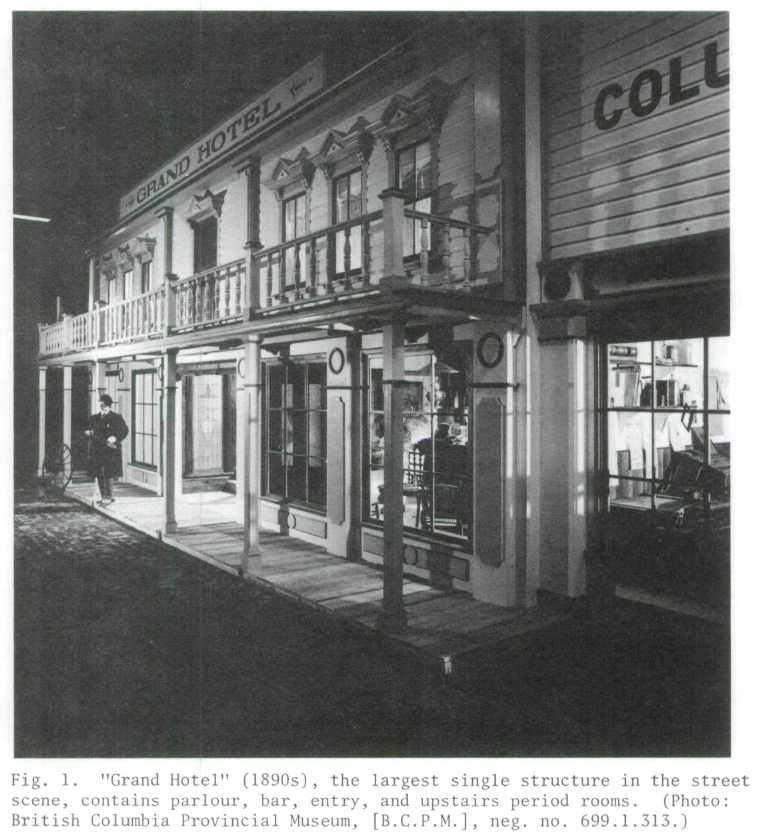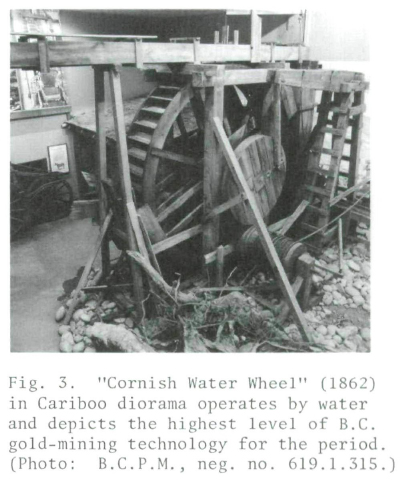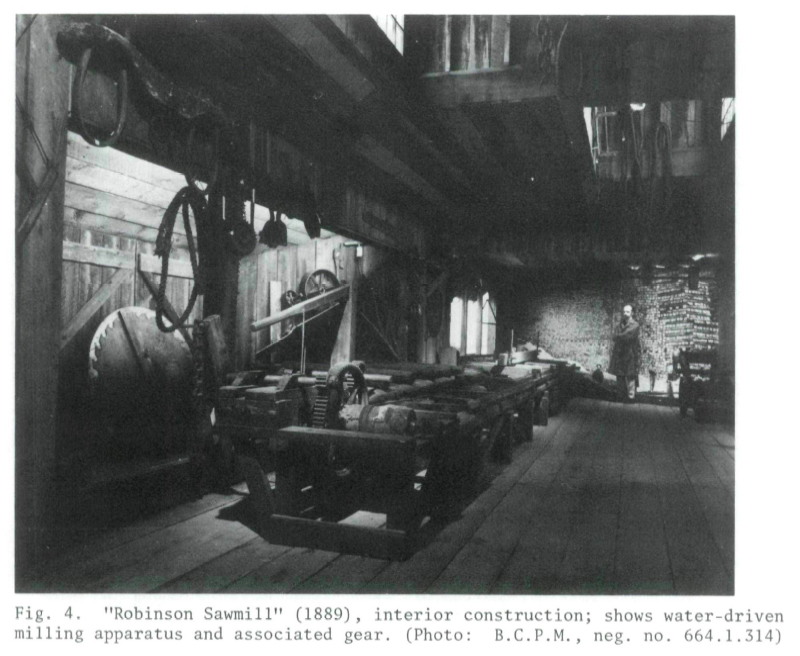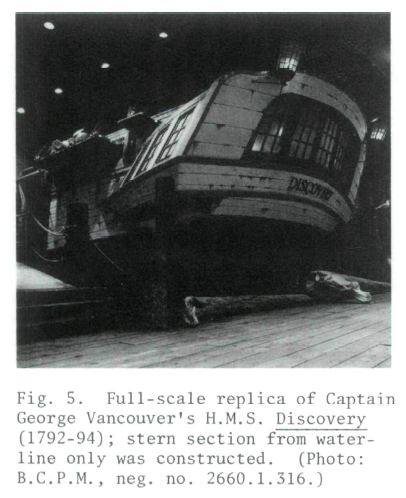Reviews / Comptes rendus
British Columbia Provincial Museum, Modem History Galleries
1 In preserving pieces from the past, museums are our most important protectors of material culture. In developing collection and exhibition policies, museums provide statements about the past and reflect current interests. The modern history exhibit at the British Columbia Provincial Museum in Victoria demonstrates these truisms well. It is an historical statement like any discussion, article, or monograph. Its curators have selected artifacts, as other historians choose data; they have presented themes as other historians develop theses. Thus, their exhibit possesses coherence, and it can be explained in terms of a sophisticated rationale. Perhaps the only significant question to be asked is — after nearly a decade is it not time to revise somewhat the original approach, to produce a new, "edited" version?
2 The exhibit opened in 1972. It was the first exhibition in the then four-year-old museum and it received the generous praise it deserved. The urban gallery did seem to be out of time, with carefully-constructed buildings, interesting displays, a fine use of photographs, a theatre, and numerous other delights. The mining exhibits were masterful reconstructions of mining enterprises and again exuded that sense of the past only possible in a good museum. The part of the exhibit devoted to Vancouver and his vessel the "Discovery" was exciting and unusual. Generally, too, the innovative use of dioramas, which complemented artifacts well and provided sometimes beautiful vistas on the province, were, in Canada, pioneering work. These highlights remain and one has only to stand for a while near any of them to see their impact on the continuing flow of visitors. It is remarkable that after nearly a decade they remain fresh and attractive.
3 There were, it appears, two general sources for the rationale behind the modern history galleries.1 The first was the priority adopted for all the museum's permanent exhibitions including modern history: to concentrate to a considerable extent on ecological themes. Such a focus was easily adapted by most of the other divisions in the museum. It posed some problems for the historians. Regrettably, most historians — especially most Canadian historians — were not (and are not) trained to place past events or people in environmental frameworks. Certainly by 1970, when the exhibit was being organized, whatever preceding impetus there had been in that direction — from the frontier and early Laurentian approaches — had become dormant. It is significant, for example, that Daniel Gallâcher, then as now the curator of the division, singles out a work by Walter Sage — produced as long ago as 1930 — as one of the intellectual seed-beds for the exhibit. The truth is, though, that Canada's academic historians could provide little direction for the exploration of such an approach — they cannot even now. Similarly, historical geographers could provide only insights and their work has progressed only marginally in the subsequent decade. Indeed, the best North American work in the field is being done in the United States by Joseph Petulla, Lawrence Lee, and others. It was a daunting priority for the historians at the division, and they are to be congratulated for undertaking such a difficult task so successfully.
4 The second source was one of the dominant thrusts in Canadian historiography in the late 1960s and early 1970s: metropolitanism and the hinterlands as espoused by J.M.S. Careless, his students, and his imitators. It was a convenient approach for the times and for this exhibit. It seemed to provide an appropriate theme — the rise of cities — and it permitted examinations of social and economic trends in new ways. It could, in fact, be related to almost everything, including the exploitation of natural resources and the development of urban environments. As for Canadian historiography generally, so for this exhibit — Careless opened many new roads and explained many old neighbourhoods.
5 Inevitably the mixture of environmentalism and metropolitanism provided a working hypothesis for the display:
6 This hypothesis, in turn, led to a focus on four eras, each of which fitted the above pattern: Fur Trade and Exploration, 1740s - 1860s; Gold Rush Era, 1840s - 1890s; Urbanization and Industrialization, 1870s - 1920s; Metropolis, 1920s - 1970s.
7 When one tours the history galleries today, one begins, as one would have in 1972, with the present. It is, unfortunately, the least successful part of the exhibit. Small display cases are assigned to each decade from the 1920s through the 1970s. The artifacts are attractive and individually interesting. They provide ample opportunities for grandfathers to tell about old telephones or mothers to describe the family's first television. But at best they are fleeting impressions of countless changes over sixty years. One can see development over those years to some extent in lighting, telephones, radio/television, children's literature, and toys. Somehow, though, the dramatic contrast between the present and the past is not demonstrated. Far be it for an historian to downplay continuity, but the changes wrought by transportation, communications, manufacturing, and computer technology in the last decades have been immense and could have provided an arresting introduction to the entire display. Nor is there an indication of what changes in the immediate—essentially urban—environment have meant for the wider environment. Perhaps, instead of focussing on decades, it would have been better to concentrate on arbitrarily chosen major developments over the last half century. Such trends as transportation, the new cities, new resource exploration, the consumer revolution, and communication changes might be appropriate to suggest the nature of modern transitions. The cost measured in terms of impact on the environment, industrialization, mechanization, out-of-province control, and rural depopulation could then be explored through photographs, maps, charts, and possibly teaching machines. It is, however, a difficult era to capture, partly because it is so close in time and partly because it is hard to know what is significant. Ultimately, the concept of metropolitanism pioneered by Careless is not particularly useful for more recent urban development; it can stimulate research, but it can apparently only superficially organize the mass of developments unearthed.
 Display large image of Figure 1
Display large image of Figure 18 One proceeds from the last sixty years to a turn-of-the-century community. This is one of the particularly successful exhibits, and it is remarkable in capturing a sense of place and time. The buildings are masterfully constructed to permit the inclusion of some twenty businesses and residences in a very limited space. The lighting—from indirect sources and vintage pieces—recaptures an evening street scene from the turn of the century most effectively. The Roxy Theatre plays a popular selection of mostly early twentieth-century "silents"; stores evoke memories from older tourists about candy and patent medicines; everywhere there are nostalgic memories, carefully prepared windows, and authentic offices and rooms. Indeed, all about are literally thousands of artifacts, most of them evocative, many of them beautiful. If there are weaknesses, they become evident only after many visits to the gallery.
9 There could be more authentic noises on the streets, aside from that coming from the theatre and the railway station. There is also an inanimate quality to nearly all the exhibits, a quality that restricts serious involvement to only a limited number of visitors. Since the later 1970s, particularly in Toronto, Ottawa, and Winnipeg, similar exhibits have included working machines and craftsmen-guides. The burden of these innovations seems to be to show how artifacts can be used to understand past relationships between man and machines and among all kinds of people. Perhaps the urban gallery could benefit from similar innovations. There could also be a more systematic exploration of who lived in British Columbia's towns and cities at the turn of the century: how many Canadian-born? how many Chinese? how many British? how many Italians? how long did they stay? what did they do?
10 A frequent visitor might develop yet one other reservation, though a solution is by no means easily found. Museums try to capture a general picture of the past, and normally only local museums can successfully be site- and time-specific. In the urban gallery, therefore, it is not clear where we are, and the overwhelming emphasis is on a middle-or upper-class Main Street. There is little sense of immediate environment, of class or ethnic division or, for that matter, of manufacturing industries — and that in a period which emphasizes industrialization. The problem, of course, is how to capture so much more as well as maintain the effects already produced. In any event, the built environment developed in the exhibit is somewhat biased; sections of the city or town are hidden, and the people from the period (as revealed in photographs or in their work places) are not as evident as they might be.
11 The relationship between the turn-of-the-century city and its natural environment is then suggested by the next series of exhibits which show the industrial history of the late nineteenth and early twentieth centuries. It would have been useful to demonstrate more concretely (possibly through charts and maps) how the towns and cities of 1900 related to their hinterlands and "superficial extractive frontiers." Similarly, it would be useful to know, on a more systematic basis, about quantities of production, workers involved, sources of funds, and ultimate market places.
 Display large image of Figure 2
Display large image of Figure 2 Display large image of Figure 3
Display large image of Figure 312 To this reviewer, the most successful exhibits in this section are related to mining. The technologies of hard rock and water wheel mining are particularly well captured; the Le Roi mine, typical of the former, is especially evocative (though some sound might be useful). Artifacts again abound, particularly drills, lamps, picks, and shovels. Perhaps the most obvious ways in which the mining exhibits might be improved are to try to show more dramatically the divisions of labour in the mines and the nature of mining towns at the turn of the century. Similarly, the impact of mining on the environment, for example, in the Kootenays shortly after 1900, was immense and could have been indicated. Nevertheless, as exhibits showing the immediate environment within which miners worked and the technology they used ca. 1900, the exhibits are successful.
13 The lumbering exhibit is similarly successful, especially because of its technological dimensions. The Robinson Sawmill (fig. 4) from 1889 shows clearly how a mill functioned and models give a sense of the evolution of lumbering technology. Again, though, quantities of production and numbers of men employed, indications of location, and charts showing where the lumber went, are not as systematically presented as they could be. Without them, one has the impression of a mammoth industry that appeared and somehow survived.
 Display large image of Figure 4
Display large image of Figure 414 The exhibits on fishing and agriculture are less compelling but for understandable reasons. The fishing industry is represented essentially by a canning factory, appropriate enough as far as it goes. The emphasis is, therefore, on land-bound technology. It would have been useful, though, especially for "those from away," to show more carefully how and when the sea was tapped of its resources, who did it, and why the resource became so important. The problem was undoubtedly one of space; perhaps more space will be devoted to this important industry in any subsequent changes. Similarly, the section on agriculture seems truncated. There is an excellent diorama on a Peace River homestead in 1912 but the remainder of the display—essentially three small exhibits reflecting frontier farming, mechanization, and a few modern trends—do not do justice to the theme. Again, the problem must partly be a shortage of space.
15 There is, of course, another explanation for the relative weakness of the agricultural and fishing exhibits. The industrial sections are situated, like the urban gallery, in the turn-of-the-century period. Many of the more dramatic developments in both fishing and agriculture occurred subsequently. Perhaps the most satisfactory answer is to indicate elsewhere, in temporary exhibits or in the section dealing with 1920-70, the dramatic changes in these areas. Again, photos, graphs, and charts might be the most effective way to do so.
16 After the industrial history and gold mining exhibits, the visitor finds a section on fur trading and exploration, 1740s-1860s. The highlight of this section is the vessel "Discovery," or at least the stern half of it (fig. 5). It succeeds in giving viewers a sense of what an eighteenth-century vessel must have been like, though space limitations restrict the related interpretation of the surrounding harbour areas (on one side, Nootka, on the other, England). There are interesting maps, a plan of the "Discovery," and several attractive, evocative artifacts, notably in Vancouver's cabin.
17 The fur trade portion of the exhibit seems to be lamentably brief, again doubtlessly because of pressure on space. There is an attractive diorama that captures what must have been the acute isolation of the mountain tops in the Stikine area in 1835 (though it does not do much else). A canot du nord is suspended above the diorama quite effectively, but somehow the drama and colour of the fur trade era are missing. The mixture of people, the immense difficulties of the trails, the role of the natives, and the complexities of post life are suggested but not really developed. Victoria in its early days is represented essentially by a meticulous model based on the 1860 situation, but there is little to suggest the nature of life in the fort. The relationship with natives is also rather weakly discussed, as in other sections as well. It is to be hoped that as the exhibits are revised more attention to this theme — as it has been explored in recent years — will be given.
18 Overall, then, the modern history exhibit is impressive, and it has helped give the museum an enviable reputation. Some flaws, however, have become evident, largely because the standards of historical evaluation have become more rigorous during the last decade. Thus, the exhibit for 1920-70 could be rethought; man's immediate environments over time could be more explicitly tied to their general environments; and some exhibits should be enlarged to reflect our expanding comprehension of their subjects. In a general way patterns of population growth — ethnicity, urban-rural proportions, immigration, and mobility — should be presented more fully. This expanded information could be presented in the form of new exhibits or in new pamphlets in the museum's very useful Gallery Leaflet series.
 Display large image of Figure 5
Display large image of Figure 519 Nevertheless, the above criticisms and suggestions are meant to be constructive; they are not meant to detract from an exceptional display and a remarkable amount of very creative work. This reviewer has visited the exhibit scores of times with friends, relatives, and — by now those most jaundiced of museum visitors — his children. Every trip has been worthwhile, and everyone on each trip has enjoyably learned something worthwhile. The staff members of the division are an untiring, dedicated group who have taught hundreds of thousands a great deal about British Columbia's past. And, despite the passage of a decade, the nucleus remains for one of the best modern history exhibits in Canada. Perhaps it is time, though — the provincial government willing and the resource revenues holding out — to re-explore the theme of man's relationship with his environment. After all, even the museum's most cherished pieces sometimes need to be retouched.
[The author is indebted to D.T. Gallacher, J.R. Wardrop, and M.Gee for their candid co-operation in the preparation of this review.]